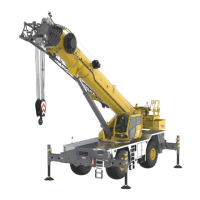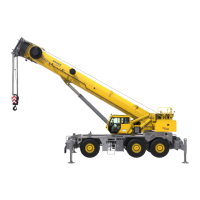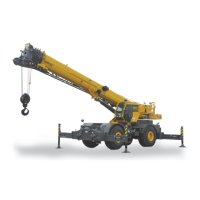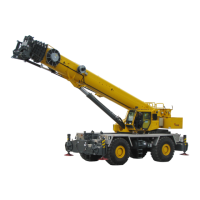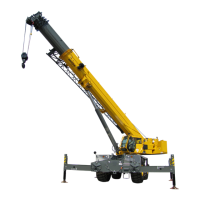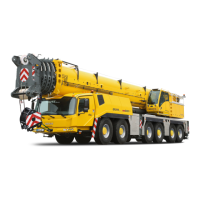7-19
GRT8100 SERVICE MANUAL POWER TRAIN
Published 3/26/2018, Control # 596-05
Water Pump
The pump should be checked carefully for leaks and proper
lubrication. Replace or rebuild if leaking, cracked, or worn.
Fans and Belts
The fan should be checked for cracked or broken blades.
Refer to Engine Drive Belts, page 7-3.
Thermostat
The thermostat is of the nonadjustable type and is
incorporated in the cooling system for the purpose of
retarding or restricting the circulation of coolant during
engine warm up. Engine overheating and loss of coolant is
sometimes due to an inoperative thermostat. To check for
this condition, remove the thermostat and test by
submerging it in hot water and noting the temperature at
which the thermostat opens and closes. Use an accurate
high temperature thermometer for making this test.
Hoses and Clamps
Hoses and their connections must be checked regularly
because they are often the source of hidden trouble. Hoses
may often times appear in good condition on the outside
while the inside will be partially deteriorated. If there are any
doubts about a hose doing its job, replacement should be
made. The clamps should be inspected to make sure they
are strong enough to hold a tight connection.
Radiator Removal and Installation
Removal
1. Set the outriggers and position the boom to over the
side.
2. Open the drain cock at the bottom of the radiator and
drain the coolant into a suitable container. Dispose of the
coolant in accordance with local and EPA regulations.
NOTE: Remove the radiator cap when draining the system
to ensure proper draining.
3. Open and remove the hood top door assembly.
4. Remove the bolts and nuts holding the rear engine hood
panel to the engine hood. This will gain access to the
rear of the radiator and the surge tank mounting
hardware.
5. Tag and disconnect the hoses from the surge tank to the
engine and from the surge tank to the radiator.
6. Remove the two bolts, washers, lockwashers and nuts
holding the surge tank to the frame. Remove the surge
tank.
7. Remove the nuts, washers and muffler clamps securing
the left and right charge air cooler tubes to the frame.
8. Remove the hose clamps and bellows connecting the
radiator to the charge air cooler tubes. Remove the hose
clamps and radiator hose connecting the radiator to the
radiator tubes.
9. Remove the bolts and washers attaching the fan shroud
to the radiator.
10. Remove the bolts, washers and lockwashers that
connect the plates to the top of the radiator and the top
of the frame rail.
11. Disconnect the electrical harness from the coolant level
sensor.
NOTE: The radiator weighs approximately 94 kg (208 lb).
12. Attach an adequate lifting device to the radiator
assembly.
13. Remove the two bolts, washers, lockwashers, nuts and
mounting bushings securing the radiator flange to the
frame mounting brackets. Remove the radiator
assembly from the carrier.
14. If a new radiator is to be installed, remove all fittings and
hoses from the old one and install them in the same
locations on the new one.
Installation
1. Ensure all fittings and hoses are installed on the radiator.
2. Position the radiator assembly in the carrier using a
lifting device. Secure the radiator flange to the frame
mounting brackets using two bolts, washers,
lockwashers, nuts and mounting bushings.
3. Reconnect the two plates between the top of the radiator
and the top of the frame rail using bolts, washers,
lockwashers and nuts.
4. Attach the fan shroud to the radiator using the bolts and
washers.
5. Connect the electrical harness to the coolant level
sensor.
6. Connect the two radiator tubes to the radiator with hose
clamps and the radiator hose. Tighten clamps to 10.2 to
11.3 Nm (90 to 100 in-lb).
7. Secure the radiator return tube to the top of the engine
using nuts, washers and a muffler clamp.
8. Reconnect the charge air cooler tubes to the CAC
radiator using hose clamps and bellows. Tighten clamps
to 11.3 Nm (100 lb-in). Do not compress spring
completely, clamp may be damaged from thermal
expansion of CAC tube.
9. Secure the charge air cooler tubes to the left and right
sides of the frame with nuts, washers and muffler
clamps.
